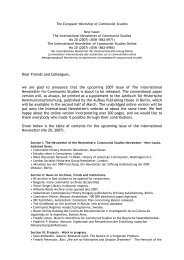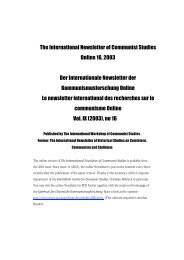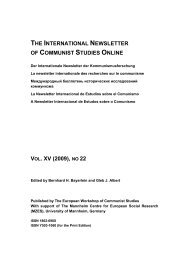Vol. XIII (2007), no 20 - The International Newsletter of Communist ...
Vol. XIII (2007), no 20 - The International Newsletter of Communist ...
Vol. XIII (2007), no 20 - The International Newsletter of Communist ...
Sie wollen auch ein ePaper? Erhöhen Sie die Reichweite Ihrer Titel.
YUMPU macht aus Druck-PDFs automatisch weboptimierte ePaper, die Google liebt.
<strong>The</strong> <strong>International</strong> Newletter <strong>of</strong> <strong>Communist</strong> Studies Online <strong>XIII</strong> (<strong><strong>20</strong>07</strong>), <strong>no</strong> <strong>20</strong> 106<br />
ideological and organisational influence the communists once had over the LAI suddenly<br />
disappeared, transforming the LAI into an overt Socialist organization.<br />
This project focuses primarily on the colonial and anti-imperialist front organization LAI, its<br />
base and network in Berlin in conjunction with Comintern headquarters in Moscow during the<br />
Inter-war era, a project that shall lead to the presentation <strong>of</strong> a dissertation on the subject. 163<br />
<strong>The</strong> LAI is an organization which has been mentioned in previous research, but its function<br />
and role as a front organization during the Inter-war has never been fairly investigated. <strong>The</strong><br />
purpose <strong>of</strong> this sy<strong>no</strong>psis is <strong>no</strong>t to go into far-reaching detail on the life and decline <strong>of</strong> the LAI,<br />
instead <strong>of</strong> this, some methodological perspectives in how to approach an organization as the<br />
LAI shall be introduced and discussed. <strong>The</strong> question, whether or <strong>no</strong>t the LAI was perceived in<br />
Moscow at Comintern headquarters as a specific important tool, apart from other Comintern<br />
front and relief organizations which could be utilized for similar purposes, shall be discussed<br />
further on, relying on empirical material and a specific case-study.<br />
<strong>The</strong> main purpose <strong>of</strong> the LAI was to act as a connective force. Relying on the principle to<br />
engage individuals and organizations (European working class organizations, radical and<br />
pacifist intellectuals active either as artists or scientists, and representatives from the<br />
colonial world) it was concerned with the social and political development in the colonial and<br />
semi-colonial part <strong>of</strong> the world, and it sought to create a common platform for these<br />
elements to join together. By preparing an international congress for 1927, LAI Secretary and<br />
Hungarian Comintern functionary Louis Gibarti claimed in 1926 that a colonial “pilgrimage”<br />
would indeed “mirror the general mood” and serve as an impressive demonstration. 164<br />
Münzenberg argued in 1928 at the Sixth Comintern Congress in Moscow that the aim <strong>of</strong> the<br />
LAI’s work was to “awaken the apathetic, to build bridges to <strong>no</strong>n-party people, to provide<br />
organizations for sympathizers with the USSR … to find recruits for communism”. 165 Some<br />
research questions consequently are linked to this: why a league against imperialism and<br />
what function and degree <strong>of</strong> importance did it have for the Comintern? In the long run, which<br />
function did a <strong>no</strong>n-party organizations as the LAI tend to assume for the Comintern, and to<br />
what extent did Comintern headquarters in Moscow try to control the organisational<br />
structures and main ideas developed in Berlin?<br />
LAI was <strong>no</strong>t the first front organization to focus on the colonies. Prototypes such as the<br />
Hands Off China Campaign (1925), the Committee against the Cruelties in Syria (1925), and<br />
the League against Colonial Oppression (LACO, 1926) had been founded, mostly active in<br />
Germany. At the Brussels Congress in February 1927, these three constellations merged with<br />
the LAI. 166 <strong>The</strong> following campaigns, committees and organizations came into existence on<br />
163<br />
<strong>The</strong> dissertation project is also a part <strong>of</strong> the research project run by Pr<strong>of</strong>essor Holger Weiss and PhD<br />
Risto Marjomaa, Comintern and African Nationalism, 1921-1935, Åbo University/Academy, Finland. For<br />
specific information see: http://www.abo.fi/fak/hf/hist/forsk_komintern.htm. Pr<strong>of</strong>essor Weiss acts as<br />
supervisor <strong>of</strong> the dissertation.<br />
164<br />
BArch R 3003/ORA/1218 Sammlung 6 – Rote Hilfe, pp. 29-30, “Der koloniale Freiheitskampf –<br />
Mitteilungsblatt der Liga gegen Unterdrückung“, Nr. 3, Berlin, 5/7-1926. Louis Gibarti (real name: Laszlo<br />
Dobos, alias used: Otto), was one <strong>of</strong> Münzenberg’s closest collaborators in the League.<br />
165<br />
Jane Degras, <strong>The</strong> <strong>Communist</strong> <strong>International</strong> 1919-1943 Documents – <strong>Vol</strong>ume II 1923-1928, Oxford<br />
University Press, 1960, p.465<br />
166<br />
Der Brüsseler Kongress. Gegen Imperialismus und für nationale Unabhängigkeit. Vom 10. bis 15.<br />
Februar 1927 im Palais Egmont – Brüssel. Auszug aus den Reden die wichtigsten Beschlüsse und














